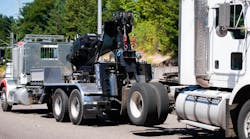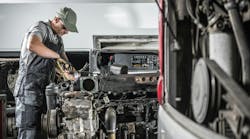There’s no such thing as a good time for downtime, especially when it’s unexpected. And one issue many fleet drivers don’t plan for is forced regens.
If you haven’t experienced this issue yet, consider yourself lucky. A forced regen occurs when soot builds up inside the diesel particulate filter (DPF) to the point that the vehicle is no longer operable. When this happens, a driver has to pull over and initiate a self-cleaning process that can take up to 40 minutes — valuable time that could have been spent on the road.
But forced regens don’t have to be the common problem they are for many fleet drivers. With one simple change, forced regens can be reduced, helping you keep your rigs in service.
Why regens occur in diesel vehicles
To get the upper hand over forced regens, it’s important to understand some mechanics. The type of soot buildup that creates the need for a regen occurs inside a specialized component of the exhaust system called the diesel particulate filter (DPF).
In recent years, DPFs have become common in diesel-powered vehicles as a means of controlling emissions. As part of the Clean Air Act, especially Phase 2 authorized by Congress in 2016, medium- and heavy-duty trucks are required to meet stricter emissions standards. To satisfy the mandate, the industry began more broadly implementing DPFs to trap soot inside a vehicle before it can be released into the air, thus reducing emissions.
This is done by forcing exhaust through a porous ceramic wall, allowing vapor to pass through while trapping impurities.
What happens during a regen
To prevent clogging, DPFs clean themselves from time to time by burning off accumulated soot. This process is referred to as regeneration because the DPF is working to “regen” itself to its original state.
When everything is working as it should, regeneration occurs automatically while the vehicle is in motion, unnoticeable to the driver. Using the heat of the exhaust itself, soot is burned off the DPF often as quickly as it accumulates. This is known as passive regeneration.
In cases where the exhaust isn’t hot enough to burn off soot on its own, the vehicle can inject fuel into the DPF, thereby raising the temperature to burn away soot. This form of regeneration, known as active regeneration, is also typically unnoticed by the driver.
The trouble begins when normal regeneration isn’t enough to burn away soot. In these cases, a forced regen is required and a driver has to pull over and wait while the DPF completes a more rigorous self-cleaning process. Failure to perform a forced regen when notified by your vehicle’s indicator system can cause severe engine damage.
How to reduce forced regens
The good news is that forced regens don’t have to be a recurring nuisance if drivers reduce impurities entering into the DPF at the start.
A premium diesel fuel like Cenex Roadmaster XL can reduce the need for DPF regeneration. With an additive package engineered to meet the demands of today’s high-performance diesel engines, Roadmaster XL provides a cleaner, more complete burn. Because it minimizes soot during combustion, Roadmaster XL can help reduce soot-related issues like forced DPF regens.
With Phase 2 emissions mandates affecting rigs through model year 2027, DPFs will likely continue their role in the industry for the foreseeable future. Learn more about how Roadmaster XL can keep your DPF clean and your operation moving.



